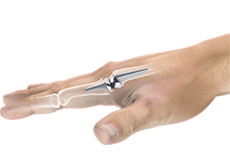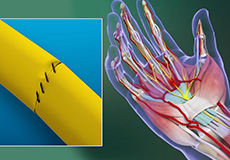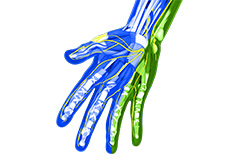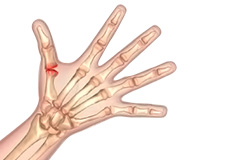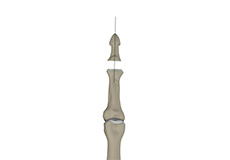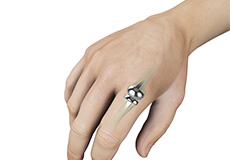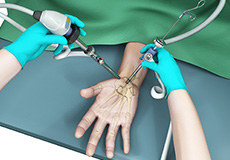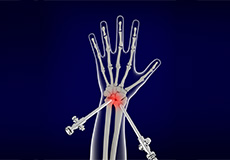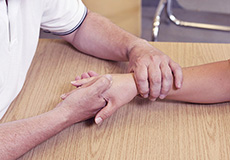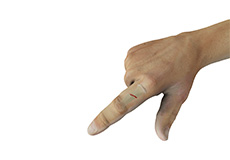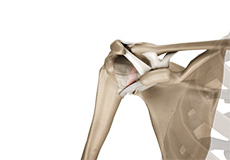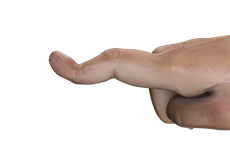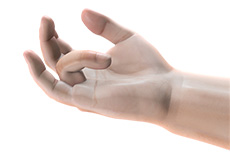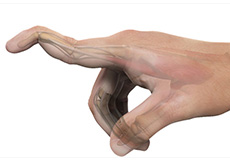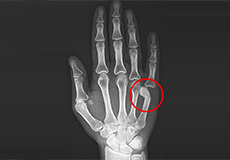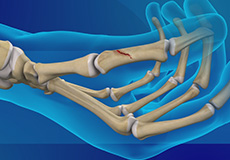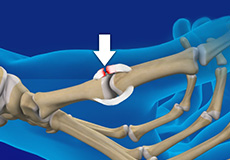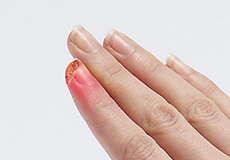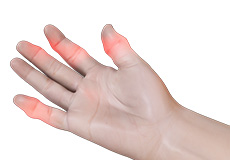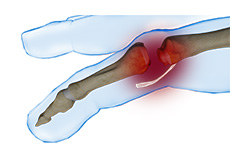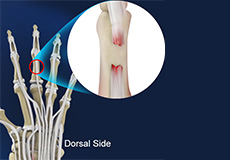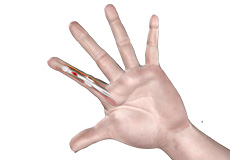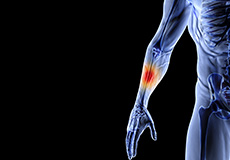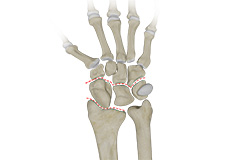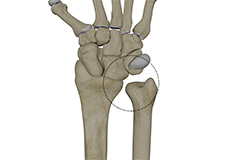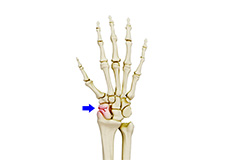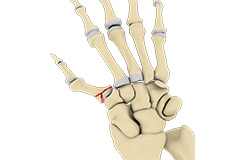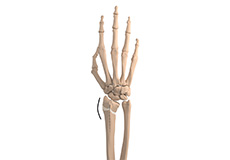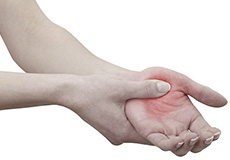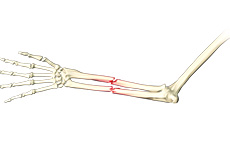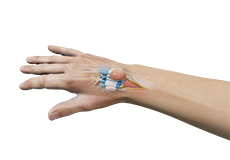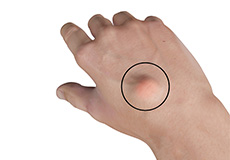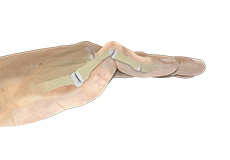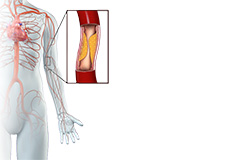-
Artificial Finger Joint Replacement
Artificial finger joint replacement is a surgical procedure that involves the removal of an arthritic or damaged finger joint and replacement with an artificial prosthesis.
-
Nerve Transfers
A nerve transfer is a surgical procedure in which a portion of a healthy nerve is transferred to the site of a damaged nerve. This procedure is performed to restore normal function at the injured site. Healthy nerves that are near the site of injury and have a similar function to the injured nerve are ideally selected as donor's nerves to improve surgical outcomes.
-
Peripheral Nerve Repair
The peripheral nerves are the nerve fibers that compose the area from head to toe, connecting the brain and spinal cord with the rest of the body parts. Nerves transmit electrical impulses and signals to and from the brain. Peripheral nervous system disorders interrupt the transmission of signals and weaken the sensory and motor nerve functions.
-
Surgery for Thumb and Digit Arthritis
Arthritis is an inflammatory condition of the joints. There are several types of arthritis; the most common type is osteoarthritis or wear-and-tear arthritis that affects the joint at the base of the thumb. Thumb arthritis is more common in women than men, and usually occurs after the age of 40 years.
-
Finger Joint Fusion
Finger joint fusion is a surgical procedure to remove the damaged bony ends of a finger joint followed by insertion of a prosthesis to fuse the bones back together. Finger joint fusion is performed to relieve arthritis pain in the fingers.
-
Finger Joint Implant
A finger joint implant is an artificial joint made of metal, plastic, or pyrocarbon components that are used to replace a severely arthritic or injured finger joint. Finger implant surgery is a motion-preserving alternative to finger joint fusion surgery.
-
Elective Emergency Hand Surgery
Hand surgery is performed to restore the structure and functionality of the fingers, wrist and hand secondary to a traumatic injury, medical condition, severe infection, or birth defect causing pain and/or deformity of the hand. It is performed by trained and certified plastic surgeons.
-
Distal Radioulnar Joint Arthroscopy
The distal radioulnar joint (DRUJ) is a pivot type synovial joint located between the radius and the ulna just proximal to the wrist joint and assists in pronation and supination of the forearm.
-
Non-Surgical Treatment of Hand and Wrist
The hand is one of the most flexible and useful parts of our body that enable us to perform many of our daily activities. The hands and wrists are prone to injuries or certain orthopedic conditions and can range from minor cuts or burns to severe arthritis or injuries of nerves, bones, and tendons.
-
Finger Arthritis
Arthritis is an inflammatory condition of the joints. There are several types of arthritis and the most common type is osteoarthritis or wear-and-tear arthritis. Arthritis affects various joints in the body and the arthritis in the hand affects the joint at the base of the thumb. Arthritis may also affect the joints of other digits.
-
Trigger Finger
Inflammation in the tenosynovium leads to a condition called trigger finger, also known as stenosing tenosynovitis or flexor tendonitis, where one of the fingers or thumb of the hand is caught in a bent position. The affected digit may straighten with a quick snap, like pulling and releasing the trigger on a gun, hence the name trigger finger.
-
Finger Fractures
A finger fracture is not a minor injury, and if left untreated, can lead to stiffness, pain, disruption of the alignment of the whole hand and interference with specialized functions such as grasping or manipulating objects. Finger fractures commonly occur during sports activities, when you break a fall or while operating machinery.
-
Ligament Injuries
A ligament is a strong, flexible band of fibrous tissue. The wrist has many ligaments that help to keep the wrist bones in proper position providing stability to the joint. A torn ligament causes the wrist bones to move out of their position, which in turn leads to wrist instability as the sprained (torn) ligament can no longer support the wrist bones.
-
Arthritis of the Thumb
Arthritis is an inflammatory condition of the joints. There are several types of arthritis. The most common type is osteoarthritis or wear-and-tear arthritis that affects the joint at the base of the thumb. Thumb arthritis is more common in women than men, and usually occurs after the age of 40 years.
-
Boutonniere Deformity
Tendons in your fingers connect the finger bones to finger muscles and help bend and straighten the finger at the joint when the muscles contract. Boutonnière deformity is a condition in which a tendon injury to the middle joint of the finger results in the inability to straighten the affected finger.
-
Dupuytren's Contracture
Dupuytren’s contracture is a hand condition where thickening of the underlying fibrous tissues of the palm causes the fingers to bend inward. This makes it difficult to fully straighten the affected fingers. It commonly occurs in the ring finger and little finger. Occasionally, the middle finger is affected, but the thumb and index finger are rarely affected.
-
Mallet Finger
A mallet finger is a condition where the end of the finger is bent and does not straighten. Mallet finger occurs when the extensor tendon at the back of the finger is damaged.
-
Boxer's Fracture
A boxer’s fracture is a break in the neck of the fifth metacarpal bone of the hand (below the pinky finger) close to the knuckle. The hand is composed of 3 types of bones: carpal or wrist bones, metacarpals or long hand bones, and phalanges or finger bones.
-
Thumb Fracture
A break or a crack in the bones of the thumb is known as a thumb fracture. Fractures may occur anywhere on the thumb, but a fracture at the base of the thumb, near the wrist, is considered the most serious.
-
Gamekeeper's Thumb
Gamekeeper's thumb, also known as skier's thumb, is a tear of the ulnar collateral ligament, a band of tissue that supports the joint at the base of the thumb.
-
Fingertip Injuries
A fingertip injury is a wound or damage caused to the most distal portion of the finger. It can be a crush, a sharp cut, a tear or a combination of these, and can result in damage to the skin, nail or nailbed, tendon, pulp, bone, and nerve endings. It is one of the most common injuries to the hand and may occur due to accidents at home, work, or play.
-
Finger Sprain
Injuries that involve tearing or stretching of the ligaments of your fingers are termed as sprains. Sprains in the fingers are most often caused from a fall when you extend your arms to reduce the impact of the fall, or from overuse or repetitive activity of the thumb such as with texting.
-
Finger Joint Dislocation & Volar Plate Injury
Finger dislocation is a condition where the bones of your finger have moved away from its normal anatomical position.
-
Extensor Tendon Injuries
Tendons are bands of tissue connecting muscles to bones. The extensor tendon is a strong, smooth cord that connects finger bones to muscles in the hand. Extensor tendons are located just under the skin, directly on the bone, on the back of the hand and fingers.
-
Flexor Tendon Injuries
Deep cuts on the under surface of the wrist, hand or fingers can cut and injure the tendon, and make it unable to bend one or more joints in a finger. When a tendon gets cut, the cut ends gets pulled away from each other like a rubber band.
-
Industrial Hand Trauma
The hand is one of the most flexible and useful parts of our body. Because of overuse in various activities, the hands are more prone to injuries, such as sprains and strains, fractures and dislocations, lacerations and amputations while operating machinery, bracing against a fall and during sports.
-
Carpal Instability
Carpal instability is the loss of alignment of the carpal bones and/or radioulnar joint. The wrist is a complex joint that connects the forearm to the hand and allows it to move. It consists of 8 small bones called carpals that articulate with two long bones of the forearm (radius and ulna).
-
Distal Radioulnar Joint (DRUJ) Instability
Distal radioulnar joint instability is the abnormal orientation or movement of the radius and ulna bones at the wrist in relation to one another. Injury to the tendons, ligaments and/or muscles stabilizing the joint may cause partial or complete dislocation.
-
Scaphoid Fracture
The scaphoid bone is a small, boat-shaped bone in the wrist, which, along with 7 other bones, forms the wrist joint. It is present on the thumb side of the wrist and is at high risk for fractures. A scaphoid fracture is usually seen in young men aged 20 to 30 years. They can occur at two places: near the thumb or near the forearm.
-
Bennett's Fracture
Bennet’s fracture is a break at the base of the first metacarpal bone (thumb bone) that meets the wrist at the first carpometacarpal (CMC) joint. The hand is composed of 3 types of bones: carpals or wrist bones, metacarpals or long hand bones, and phalanges or finger bones.
-
Malunion of a Fracture
Malunion of a fracture is a condition where the fractured ends of a bone heal in a misaligned position resulting in bone deformity. Malunions may occur in any bone fractures in the body often due to trauma.
-
Hand Pain
Injury or inflammation of any of these structures, due to a disorder or disease condition, may produce hand pain. Even compression of the nerves supplying these structures may cause hand pain.
-
Work Related Hand Injuries
The hand is one of the most flexible and useful parts of our body that assist us in most workplace activities. Hand injuries can range from minor cuts or burns to severe injuries.
-
Adult Forearm Fractures
The forearm is made up of 2 bones, namely, the radius and ulna. The primary function of your forearm is rotation i.e., the ability to turn your palm up and down. The fracture of the forearm affects the ability to rotate your arm, as well as bend and straighten the wrist and elbow.
-
Ganglion Cyst
Ganglion cysts are swellings that most commonly develop along the tendons or joints of wrists or hands. They can be found either at the top of the wrist, palm side of the wrist, end joint of a finger or at the base of a finger. A ganglion cyst is not cancerous and will not spread to the other parts of the body.
-
Hand Tumors
Any abnormal lump or bump on the hand is considered a hand tumor. Hand tumors can occur on the skin as a mole or a wart, underneath the skin soft tissue or on the bone. Most hand tumors are benign (non-cancerous); however, they can also rarely be malignant (cancerous).
-
Swan Neck Deformity
The finger joint is a hinge joint that allows the bending and straightening of the fingers. Each finger is composed of 3 phalange bones joined by 2 interphalangeal joints (IP joints). The joint near the base of the finger is called the proximal IP joint (PIP joint), and the joint near the tip of the finger is called the distal IP joint (DIP joint).
-
Upper Limb (Arm) Artery Disease
Upper limb (arm) artery disease is a condition where an artery between the chest and the hand is blocked and does not supply blood to the arms. The narrowing or blockage of the artery may be caused due to atherosclerosis (hardening of the arteries due to plaque build-up).
Hand Anatomy
The human hand is made up of the wrist, palm, and fingers and consists of 27 bones, 27 joints, 34 muscles, over 100 ligaments and tendons, and many blood vessels and nerves.
The hands enable us to perform many of our daily activities such as driving, writing and cooking. It is important to understand the normal anatomy of the hand to learn more about diseases and conditions that can affect our hands.
Bones of the Hand
The wrist is comprised of 8 carpal bones. These wrist bones are attached to the radius and ulna of the forearm to form the wrist joint. They connect to 5 metacarpal bones that form the palm of the hand. Each metacarpal bone connects to one finger at a joint called the metacarpophalangeal joint (MCP joint). This joint is commonly referred to as the knuckle joint.
The bones in our fingers and thumb are called phalanges. Each finger has 3 phalanges separated by two interphalangeal joints, except for the thumb, which has only 2 phalanges and one interphalangeal joint.
The first joint close to the knuckle joint is called the proximal interphalangeal joint (PIP joint). The joint closest to the end of the finger is called the distal interphalangeal joint (DIP joint).
The MCP and PIP joint act like hinges when the fingers bend and straighten.
Soft Tissues of the Hand
Our hand bones are held in place and supported by various soft tissues. These include: articular cartilage, ligaments, muscles and tendons.
Articular cartilages are smooth material that act as shock absorbers and cushion the ends of bones at each of the 27 joints, allowing smooth movement of the hand.
Muscles and ligaments function to control the movement of the hand.
Ligaments are tough rope-like tissues that connect bones to other bones, holding them in place and providing stability to the joints. Each finger joint has two collateral ligaments on either side, which prevents the abnormal sideways bending of the joints. The volar plate is the strongest ligament in the hand. It joins the proximal and middle phalanx on the palm side of the joint and prevents backward bending of the PIP joint (hyperextension).
Muscles of the Hand
Muscles are fibrous tissues that help produce movement. They work by contracting.
There are two types of muscles in the hand:
- Intrinsic muscles are small muscles that originate in the wrist and hand. They are responsible for fine motor movements of the fingers during activities such as writing or playing the piano.
- Extrinsic muscles that originate in the forearm or elbow control the movement of the wrist and hand. These muscles are responsible for gross hand movements. They position the wrist and hand while the fingers perform fine motor movements.
Each finger has six muscles controlling its movement: three extrinsic and three intrinsic muscles. The index and little finger each have an extra extrinsic extensor.
Tendons of the Hand
Tendons are soft tissues that connect muscles to bones. When muscles contract, tendons pull the bones, causing the finger to move. The extrinsic muscles are attached to finger bones through long tendons that extend from the forearm through the wrist. Tendons located on the palm side help in bending the fingers and are called flexor tendons, while tendons on top of the hand called extensor tendons help in straightening the fingers.
Nerves of the Hand
Nerves of the hand carry electrical signals from the brain to the muscles in the forearm and hand, enabling movement. They also carry the senses of touch, pain and temperature back from the hands to the brain.
The three main nerves of the hand and wrist include:
- Ulnar nerve: The ulnar nerve crosses the wrist through an area called Guyon’s canal and branches to provide sensation to the little finger and half of the ring finger.
- Median nerve: The median nerve crosses the wrist through a tunnel called the carpal tunnel. The median nerve provides sensation to the palm, thumb, index finger, middle finger and part of the ring finger.
- Radial nerve: The radial nerve runs down the thumb side of the forearm and provides sensation to the back of the hand from the thumb to the middle finger.
All three nerves originate at the shoulder and travel down the arm to the hand. Each of these nerves has sensory and motor components.
Blood Vessels of the Hand
Blood vessels travel beside the nerves to supply blood to the hand. The main arteries are the ulnar and radial arteries, which supply blood to the front of the hand, fingers, and thumb. The ulnar artery travels next to the ulnar nerve through the Guyon’s canal in the wrist. The radial artery is the largest artery of the hand, traveling across the front of the wrist, near the thumb. Pulse is measured at the radial artery.
Other blood vessels travel across the back of the wrist to supply blood to the back of the hand, fingers and thumb.
Bursae of the Hand
Bursae are small fluid-filled sacs that decrease friction between tendons and bone or skin. They contain special cells called synovial cells that secrete a lubricating fluid.
Learn more about the various diseases and conditions affecting the hand and wrist from the American Society for Surgery of the Hand (ASSH)
- Amputation: Prosthetic Hand and Fingers
- Animal Bite
- Arm Cast and Splint Care
- Arm, Hand and Finger Replantation
- Birth Defects: Congenital Hand Differences
- Boutonniere Deformity
- Boxer's Fracture
- Brachial Plexus Injury
- Broken Arm
- Broken Finger Tip
- Broken Hand
- Carpal Boss
- Carpal Tunnel Syndrome
- Cigarettes and Hand Conditions
- Cold Hands
- Complex Regional Pain Syndrome - CRPS
- Cortisone Shot
- Cubital Tunnel Syndrome
- De Quervain's Tenosynovitis
- Dislocated Shoulder
- Distal Bicep Tendonitis
- Dupuytren's Contracture
- Elbow Fractures
- Elbow Pain: Stiffness
- Elbow Surgery: Arthroscopy
- Extensor Tendon Injury
- Fibromyalgia Hand Pain
- Flexor Tendon Injury
- Fractures in Children
- Frostbite in Hands
- Ganglion Cyst
- Golf Injuries to the Hand, Wrist or Elbow
- Gout in Hands
- Hand Cramps (Focal Dystonia)
- Hand Infection
- Hand Surgery Anesthesia
- Hand Therapy
- Hand and Finger Exercises
- Heat Treatment and Cold Treatment
- How to Treat a Burn
- Jammed Finger
- Jersey Finger
- Kienbock's Disease
- Knuckle, Wrist & Finger Joint Replacement
- MCP Joint Arthritis
- Mallet Finger
- Nail Bed Injury
- Nerve Damage and Repair
- Nerve Injury
- Numbness in Hands
- Olecranon Bursitis
- Osteoarthritis
- Pain Management: How to Get Pain Relief
- Pain Medication: What are Opioids?
- Paraffin Wax Bath
- Pseudogout
- Psoriatic Arthritis
- Rheumatoid Arthritis
- Rotator Cuff Injury
- Scaphoid Fracture
- Scapholunate Torn Ligament
- Scar Treatment
- Shoulder Arthritis
- Shoulder Fracture
- Shoulder Pain
- Skiing and Snowboarding Injury Prevention
- Skin Cancer of the Hand and Upper Extremity
- Sprained Thumb
- Sprained Wrist
- Stiff Hands
- Swan Neck Deformity
- Swollen Fingers
- Systemic Disease
- TFCC Tear
- Tendon Transfer Surgery
- Tennis Elbow - Lateral Epicondylitis
- Thumb Arthritis
- Trigger Finger
- Ulnar Wrist Pain
- Vascular Disease
- Warts on Hands
- Wrist Arthritis
- Wrist Fracture
- Wrist Surgery: Arthroscopy
- Wrist or Hand Tumor


